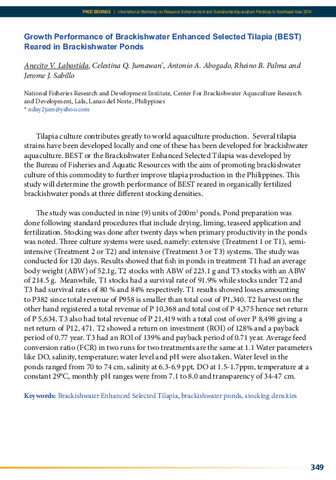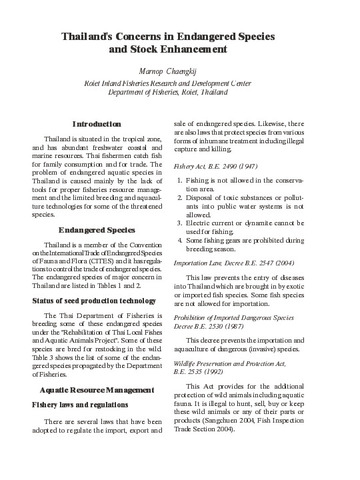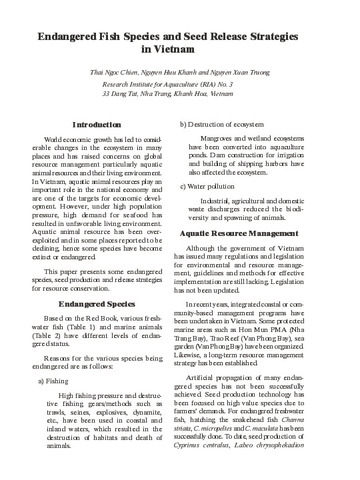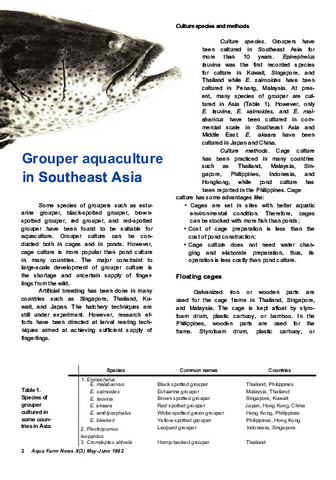Growth performance of brackishwater enhanced selected tilapia (BEST) reared in brackishwater ponds
- Global styles
- MLA
- Vancouver
- Elsevier - Harvard
- APA
- Help
Share
Abstract
Tilapia culture contributes greatly to world aquaculture production. Several tilapia strains have been developed locally and one of these has been developed for brackishwater aquaculture. BEST or the Brackishwater Enhanced Selected Tilapia was developed by the Bureau of Fisheries and Aquatic Resources with the aim of promoting brackishwater culture of this commodity to further improve tilapia production in the Philippines. This study will determine the growth performance of BEST reared in organically fertilized brackishwater ponds at three different stocking densities.
The study was conducted in nine (9) units of 200m2 ponds. Pond preparation was done following standard procedures that include drying, liming, teaseed application and fertilization. Stocking was done after twenty days when primary productivity in the ponds was noted. Three culture systems were used, namely: extensive (Treatment 1 or T1), semiintensive (Treatment 2 or T2) and intensive (Treatment 3 or T3) systems. The study was conducted for 120 days. Results showed that fish in ponds in treatment T1 had an average body weight (ABW) of 52.1g, T2 stocks with ABW of 223.1 g and T3 stocks with an ABW of 214.5 g. Meanwhile, T1 stocks had a survival rate of 91.9% while stocks under T2 and T3 had survival rates of 80 % and 84% respectively. T1 results showed losses amounting to P382 since total revenue of P958 is smaller than total cost of P1,340. T2 harvest on the other hand registered a total revenue of P 10,368 and total cost of P 4,375 hence net return of P 5,634. T3 also had total revenue of P 21,419 with a total cost of over P 8,498 giving a net return of P12, 471. T2 showed a return on investment (ROI) of 128% and a payback period of 0.77 year. T3 had an ROI of 139% and payback period of 0.71 year. Average feed conversion ratio (FCR) in two runs for two treatments are the same at 1.1 Water parameters like DO, salinity, temperature; water level and pH were also taken. Water level in the ponds ranged from 70 to 74 cm, salinity at 6.3-6.9 ppt, DO at 1.5-1.7ppm, temperature at a constant 29°C, monthly pH ranges were from 7.1 to 8.0 and transparency of 34-47 cm.
Description
Abstract only.
Suggested Citation
Labastida, A. V., Jumawan, C. Q., Abogado, A. A., Palma, R. B., & Sabillo, J. J. (2015). Growth performance of brackishwater enhanced selected tilapia (BEST) reared in brackishwater ponds. In M. R. R. Romana-Eguia, F. D. Parado-Estepa, N. D. Salayo, & M. J. H. Lebata-Ramos (Eds.), Resource Enhancement and Sustainable Aquaculture Practices in Southeast Asia: Challenges in Responsible Production of Aquatic Species: Proceedings of the International Workshop on Resource Enhancement and Sustainable Aquaculture Practices in Southeast Asia 2014 (RESA) (p. 349). Tigbauan, Iloilo, Philippines: Aquaculture Department, Southeast Asian Fisheries Development Center.
Type
Conference paperISBN
9789719931041
Related items
Showing items related by title, author, creator and subject.
-
Thailand's concerns in endangered species and stock enhancement
Chaengkij, Marnop (Aquaculture Department, Southeast Asian Fisheries Development Center, 2006)The paper provides a comprehensive list of endangered freshwater, brackishwater, and marine aquatic species in Thailand. The Thai Department of Fisheries is breeding some of the endangered species under the “Rehabilitation ... -
Endangered fish species and seed release strategies in Vietnam
Chien, Thai Ngoc; Khanh, Nguyen Huu; Truong, Nguyen Xuan (Aquaculture Department, Southeast Asian Fisheries Development Center, 2006)World economic growth has led to considerable changes in the ecosystem in many places and has raised concerns on global resource management particularly aquatic animal resources and their living environment. In Vietnam, ... -
Grouper aquaculture in Southeast Asia
Castaños, Milagros T.; Southeast Asian Fisheries Development Center, Aquaculture Department (Aquaculture Department, Southeast Asian Fisheries Development Center, 1992)





